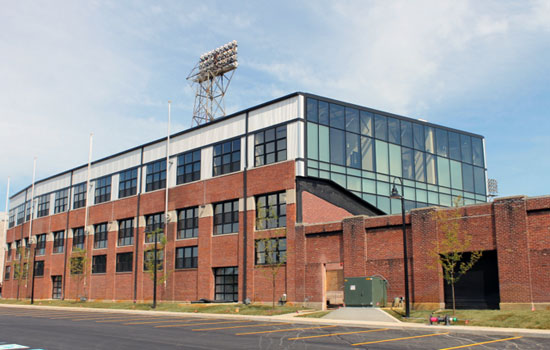Bush Stadium was the backdrop for plenty of baseball history during its long and storied tenure as home to the Indianapolis Indians. Its post-baseball years have also been unique, as it was converted for another purpose before falling into a state of disrepair and then being revived. As a result, Bush Stadium lives on in several unique ways, including at its site and other locations in Indianapolis.
When it first opened in 1931, Bush Stadium was known as Perry Stadium. It became Victory Field in 1942, retaining that name until it was rededicated in honor of former major leaguer and Indianapolis Indians president Donie Bush in the late 1960’s.
Bush Stadium saw plenty of memorable moments during its history. The Indians achieved several milestones while playing at Bush Stadium, including league championships in 1949, 1956, 1963, 1982, 1986, 1987, 1988, 1989, and 1994. There were also a number of notable players who played for the Indians over that era, including future Hall of Famers Harmon Killebrew and Randy Johnson.
In addition to the Indians, the ballpark was at one point the home of the Indianapolis Clowns of the Negro Leagues. Hank Aaron suited up for the Clowns in 1952, before being sold to the Boston Braves. That same year, the Clowns won the Negro American League championship.
Aside from what happened on the field, Bush Stadium became memorable in several other respects. It featured ivy on its outfield wall, prompting Chicago Cubs president Bill Veeck’s suggestion to P.K. Wrigley that it be added to the outfield wall at Wrigley Field as part of renovations completed in 1937.
Bush Stadium also made an appearance in film. It was used in the production of the 1988 movie Eight Men Out—a dramatization of the 1919 Black Sox scandal—serving as the setting for the baseball scenes.
Bush Stadium’s run as a professional baseball facility came to an end in July 1996, when the Indians moved to the new Victory Field in downtown Indianapolis. With baseball out of the picture, Bush Stadium was converted into a racetrack, becoming known as 16th Street Speedway. The racetrack proved to be short lived, however, as it closed in 1999.
Following the closing of the racetrack, Bush Stadium was mostly abandoned. The ballpark’s condition deteriorated, putting its future in doubt, while the cars stored as part of the federal government’s Cash for Clunkers took over what had been its playing surface.
Fortunately for baseball fans and preservations alike, an effort to repurpose Bush Stadium eventually surfaced. In 2013, Core Redevelopment completed a project that converted the property into an apartment building known as Stadium Lofts. While this required the demolition of the seating bowl, many of Bush Stadium’s most striking features were left intact. The same stone art deco entrance that greeted fans for decades now serves as the façade of the apartment building, while a few light towers, the scoreboard and a portion of the outfield wall have been preserved.
Stadium Lofts even includes a commemoration of the playing field. Stamped concrete mimics the look of infield dirt and is surrounded by grass to give it the appearance of Bush Stadium’s playing surface.
Preserving the ballpark itself was a major feat, but the legacy of Bush Stadium does not stop there. The organization People for Urban Progress (PUP) salvaged 11,000 seats from the ballpark, with many of them installed at bus stops and other locations. Seats can also be found outside the entrance of Stadium Lofts. PUP has salvaged materials from other Indianapolis facilities, including the RCA Dome, the former home of the NFL’s Colts that was demolished in 2008.
Bush Stadium was an iconic Minor League Baseball ballpark, not only serving as home of one of the sport’s signature franchises but also being the site of plenty of memorable moments. The structure’s days as a baseball facility are over, but preservation efforts have allowed its legacy to live on, leaving signs of Bush Stadium around Indianapolis for years to come.
Images of Stadium Lofts courtesy Core Redevelopment.
This article first appeared in the Ballpark Digest newsletter. Are you a subscriber? It’s free, and you’ll see features like this before they appear on the Web. Go here to subscribe to the Ballpark Digest newsletter.
Previous Ballparks That Live on Entries:



